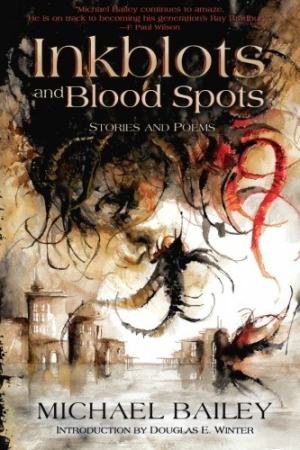
Inkblots and Blood Spots
For those with an appetite for atypical horror fare, Bailey’s range is satisfyingly wide.
Bram Stoker Award nominee Michael Bailey has an ax to grind with horror fiction. In the disjointed Inkblots and Blood Spots, his latest collection to buck the genre’s blood-fests-and-madness conventions, he widens the scope of horror subjects, makes challenging stylistic choices, and invests his characters with an emotional weight that heightens the stakes of terror.
The stories in Inkblots and Blood Spots engage with the macabre but also with sci-fi, fantasy, and historical fiction. Bailey features desperate parents, besotted children, harassed hit women, anemic carnival clowns, grieving pyromaniacs, even a bereft Dr. Frankenstein reimagined for the digital age. They meet fates by turns creepy, gruesome, sweet, and wholly mysterious.
Referencing Einstein’s quote, “The only reason for time is so everything doesn’t happen at once,” Bailey begins with “Hiatus,” a surreal tale of a family man who makes a regrettable choice when he assumes he is the lone survivor of a time-stopping event. The sci-fi nail-biter “Bootstrap/The Binds of Lasolastica” follows, featuring a grieving scientist who convinces a dying man to undergo a mind transplant. In the vividly frightening “Underwater Ferris Wheel,” Bailey switches between second- and third-person narration, prolonging dread, as a mysterious carnival clown draws a boy away from his mother. And in the richly drawn “The Dying Gaul,” stanzas from Lord Byron’s early poem Childe Harold’s Pilgrimage are interspersed with an imagining of the passionate relationship between a violent gladiator’s female mistress and his boy lover.
Given to writing long and unfortunate metaphors—a deadly fire in the gruesome family drama “Mum” is “a damn social network of destruction” and a parking lot frozen in time in “Hiatus” is “filled with cars playing Tetris”—Bailey is at his best when he clips his prose and dives into the action. In the sweetly affecting “A Light in the Closet,” a little girl unnerved by the death of her soldier brother says right away, “Bogey was in my room again last night.” A similar clarity prevails in “Skinny,” a story Bailey originally published under the pseudonym Julie Stipes. The florid entries in a young woman’s weight loss diary become frighteningly spare as the pounds drop away and her very self reduces to numbers:
August – 79 lbs, 12 oz.
September – 79 lbs, 3 oz.
October – 78 lbs, 6 oz.
November – 78 lbs, 0 oz.
Bailey makes interesting stylistic choices, including abandoned endings and a lengthy parallel narrative in a story about childhood regret and 9/11. And he weaves poetry through his prose, along with story-specific artwork from illustrator Daniele Serra. Serra’s dark watercolors add a bruising elegance to the book, but the poetry is hit or miss, often sounding simple and tacked-on:
Why do rainbows frown
with their prismatic lips on the ground?
Exposed by the rain
painted by the sun
their smiles lie buried
not making a sound
Are they hiding something from us?
Marrying art and poetry to text can help frame a collection. But despite a mini section on costumed characters and balloons, there is not enough pattern in tone, style, or content running through the stories for any real coherence.
If Inkblots and Blood Spots is about anything, it’s about spotlighting Bailey’s range; and for those with an appetite for atypical horror fare, that range is satisfyingly wide.
Reviewed by
Lauren Dockett
Disclosure: This article is not an endorsement, but a review. The publisher of this book provided free copies of the book and paid a small fee to have their book reviewed by a professional reviewer. Foreword Reviews and Clarion Reviews make no guarantee that the publisher will receive a positive review. Foreword Magazine, Inc. is disclosing this in accordance with the Federal Trade Commission’s 16 CFR, Part 255.
